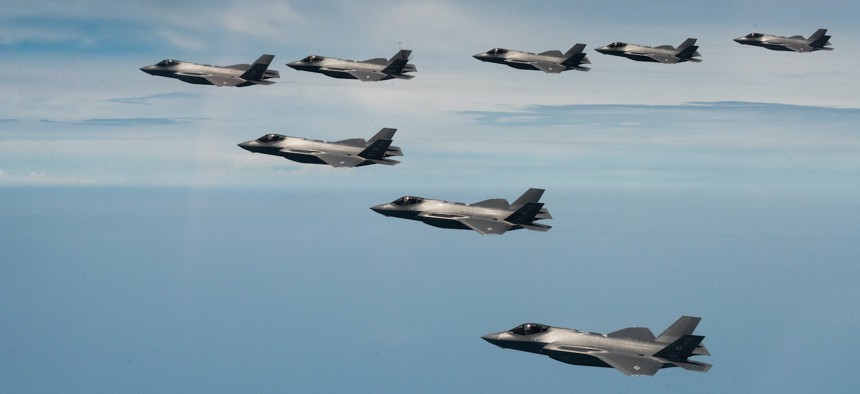
U.S. Air Force F-35 Lightning IIs fly with Republic of Korea Air Force F-35s as part of a bilateral exercise over the Yellow Sea, Republic of Korea, July 12, 2022. U.S. Air Force / Senior Airman Trevor Gordnier
How many F-35 versions are there? Hint: more than 3
Fixes and upgrades have maintainers dealing with more than a dozen flavors of the Lightning II.
The F-35 program, pitched as a way to equip three services with one largely similar aircraft, has now produced “at least 14 different versions” of the Lightning II, according to a report from a government watchdog agency.
“Extensive” differences in the variants are complicating maintenance and sustainability, contributing to the program’s poor readiness, the Government Accountability Office said in its report.
“There are numerous modifications in the different lots of the three variants of the F-35 that impact depot maintenance of the F-35A, F-35B, and F-35C,” F-35 Joint Program Office spokesperson Russ Goemaere told Defense One.
The problem can be traced back to the Pentagon’s early-1990s decision to start building the aircraft before it settled on a design, the GAO said. Subsequent fixes, upgrades, and new requirements mean early production jets look a lot different than those being delivered today.
“Officials at the program’s two air vehicle depots told us there are extensive variations in the workload required for each modification package, and they maintain different aircraft configurations because of hardware differences across production lots,” GAO said.
This makes scheduling maintenance difficult because the time it takes to fix each F-35, and the type of work needed, “fluctuates considerably,” GAO said.
The amount of time it takes for an aircraft to go through depot maintenance depends on the modifications planned for the aircraft, the JPO said.
“The modification program executes a yearly Modification Workload Review with all program customers. During this review, the program office, depots, and each program customer agree to the aircraft modification requirements, which can vary driven by aircraft lot and individual customer input,” Goemaere said.
Lockheed delivers F-35s in production lots, which are essentially batches of aircraft. But usually the company is delivering a blend of aircraft across different lots. The Pentagon and Lockheed finished negotiations for three batches of jets—known as lots 15, 16, and 17—last year, and the company said it hopes to reach an agreement on the next two lots, 18 and 19, before the end of the year.
Additionally, the program is still in its initial operational testing and low-rate initial production phase, but the Pentagon is producing the aircraft as though it is in the full-rate production phase, exacerbating the program’s maintenance problems.
“Low-rate initial production aircraft, according to DOD officials, are delivered in lots that are inherently a different configuration due to nominally increased capabilities that create configuration management problems for the program,” GAO said.
The Pentagon recently announced the program has finished a series of virtual combat tests that should pave the way for the program to move to full-rate production. But if test results reveal problems with the jet, that would mean some of the 900-plus aircraft already delivered must be fixed, further jamming up maintenance depots.



